
by Mark Smiley | Apr 28, 2017 | Main Articles
City Supplements Its Destruction Of Cherry Creek Retail With That Of South Broadway
by Mark Smiley

 The City and County of Denver, fresh from creating chaos and consternation among Cherry Creek retail businesses by failing to plan and provide sufficient parking and traffic flow, has now set its sights on creative destruction of small businesses along South Broadway with the innovative use of bike lanes.
The City and County of Denver, fresh from creating chaos and consternation among Cherry Creek retail businesses by failing to plan and provide sufficient parking and traffic flow, has now set its sights on creative destruction of small businesses along South Broadway with the innovative use of bike lanes.
Le Grue’s Flowers and Gifts has been a small business anchor on South Broadway for decades. Today, there is a sign in the front window that says “Can’t find parking? Bike lane slowing your commute? Call City Council.” Owner Alan Bemel says his customers have plenty of complaints, but laments, “I don’t think City Council is listening.”
Some small businesses like Le Grue’s along this stretch of South Broadway are hurting and they blame Denver’s new bike lane plan.
Test Project
Last August, Denver Public Works built a temporary, “test” two-way protected bike lane along a half-mile stretch of South Broadway. It runs from Bayaud to Virginia Avenue. It’s part of the Denver Moves project, a plan to enhance bicycle facilities in the downtown area and throughout the city.
In order to build it, the City took away one vehicle traffic lane and installed a two-way protected bike lane next to the sidewalk. The City also had to sacrifice a significant number of on-street parking spaces to accommodate the bike lane. Denver Public Works spokeswoman Nancy Kuhn says there were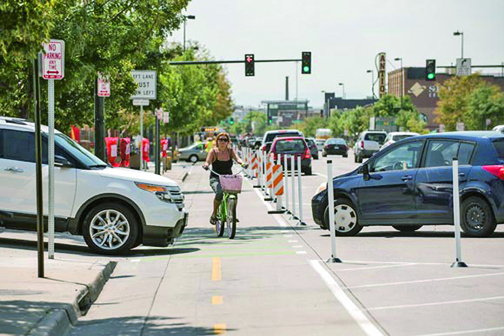 98 parking spaces along the half-mile stretch but now there are 79, a loss of 19 spots.
98 parking spaces along the half-mile stretch but now there are 79, a loss of 19 spots.
Businesses call it a “disaster,” but somehow the City of Denver has declared the South Broadway bike lane a “success” and is moving forward with plans to design not only a permanent but significantly longer bike lane, along the main corridor.
“It’s a nightmare,” lamented one owner behind the counter of a South Broadway liquor store. “A nightmare,” he repeated. “My customers can’t find a place to park and neither can the delivery trucks.” He says the loading zones are too small and delivery trucks have to endlessly circle the block, often forced to park in a through lane which further snarls traffic. He says the bikeway has definitely hurt his business.
Le Grue’s owner Bemel agrees. He says, “Last month my sales tax revenues were the lowest in I don’t know how many years. I attribute that to the bike lane.”
He explains his walk-in business has all but disappeared and even loyal customers complain they can’t find a place to park and therefore shop less at his establishment.
Simple Mathematics
Fat Willy, owner of Fat Willy’s NBS Electronics on South Broadway predicted problems when the test bikeway was first installed. At the time, he said, “It’s a simple matter of mathematics. If you’re going to take space for a bike lane you have to take it away from cars.” Recent posts on Fat Willy’s Facebook page complain his fears have come true. One post says, “I don’t know a single merchant who hasn’t lost money since the stupid thing was forced on people who didn’t want it and were never consulted in the first place.” The post writes that quick access places like restaurants, coffee shops and liquor stores are affected the most with some businesses down as much as 40% because of the bike lane.
Other businesses have also encouraged frustrated shoppers to contact Denver City Council and ask them to get rid of the bike lane. But one business owner sighed saying, “But I don’t think anyone is going to listen, I think they’ve made up their minds and it’s a done deal.”
It may well be. From the beginning, when Denver Public Works first installed the half-mile bike lane “test,” city officials admitted that barring an unexpected safety issue, the ultimate plan was to remove one lane of vehicle traffic and install a permanent bike lane all the way from I-25 and South Broadway to Colfax Avenue downtown.
City Argument
The Denver Public Works website says the city’s surveys and evaluations show the test bike lane dramatically reduced the number of people riding bicycles on the sidewalk and that makes cyclists and pedestrians feel safer.
riding bicycles on the sidewalk and that makes cyclists and pedestrians feel safer.
The City further claims taking away one vehicle traffic lane had almost no impact on drive time. Before installation of the bikeway, peak period travel time from Colfax to I-25 was an average of 11 minutes, 50 seconds. After installation, the average travel time was 11 minutes, 59 seconds. An increase of just nine seconds.
The Public Works says its website survey also shows strong support for the bike lane and bicyclists and nearby residents we talked to say they do think it’s a good idea.
Small Business Reply
But many small businesses and disgruntled city employees indicate that it is all of scam and a con by the City and County of Denver. They laugh that a website survey can be easily manipulated and the only persons that individuals in Public Works actually talk to are each other.
An individual with the City revealed (whose name was withheld due to his employment status and the sensitive nature of the project):
“Everyone knows Mayor Hancock and Planning Director Buchanan are more or less owned by the real estate developers who could care less about small retail businesses. The City is not planning for parking or traffic flow since that might negatively impact the approval of various projects.
“The undisclosed working model for the city is Saigon 1968 where most everyone got from point to point by bike or public transportation. You don’t need to worry about parking or auto traffic if there aren’t very many cars. What families with young kids do in mid-winter in Denver who knows, but this is a millennial oriented administration who doesn’t like the concept of young families. Those people who can’t go along with the program can all move to the stinking suburbs as far as the Administration is concerned.”
“They are going to build bike lanes everywhere. If the Saigon ’68 model doesn’t work who cares? Buchanan will be back at his big ranch in Strasburg, while Hancock will be on a beach in South Florida with all of his ill-gotten gains.”
The Public Works website says roughly 32,000 vehicles on average travel South Broadway between Bayaud and Virginia each day.
The city says over a three-month period, an average of 52 bikes used the bike lane each day.
Many of the small businesses along South Broadway question the City’s decision to inconvenience tens of thousands of drivers and potential customers for the sake of a few dozen bicyclists. They suggest if the City really feels a bike lane is necessary, simply put it a block or two over on a side street instead of on a main corridor.
City Plans
The city plans to ask for proposals to design a permanent bike lane along South Broadway, from I-25 to Cherry Creek within the next several weeks. Part of the plan will also include transitioning the current peak-only bus lane to a 24-hour bus lane. Spokeswoman Nancy Kuhn says they know that parking is important and part of any design plan will take that into consideration.
The money is available to pay for the initial design plans, but the city does not have the money to actually build a permanent bikeway on South Broadway. The project could be part of a bond measure that voters will decide on this November.
Councilman Jolon Clark whose District 7 includes South Broadway stated to the Chronicle that he was aware of the parking concerns of small businesses in the area and he believes the final bikeway design will address them. Regarding the virtually empty bike lane he believes that usage of the lane will increase significantly once it is extended all the way to Cherry Creek.
Some South Broadway business owners hope voters pay attention the next election. A Fat Willy Facebook post puts it this way, “This is what happens when green-weenie global warming bozos get a bee in their bonnets and decide to do something that doesn’t need to be done … Please try to remember what these fools have done to the small business people who can’t fight back when the next election rolls around.”
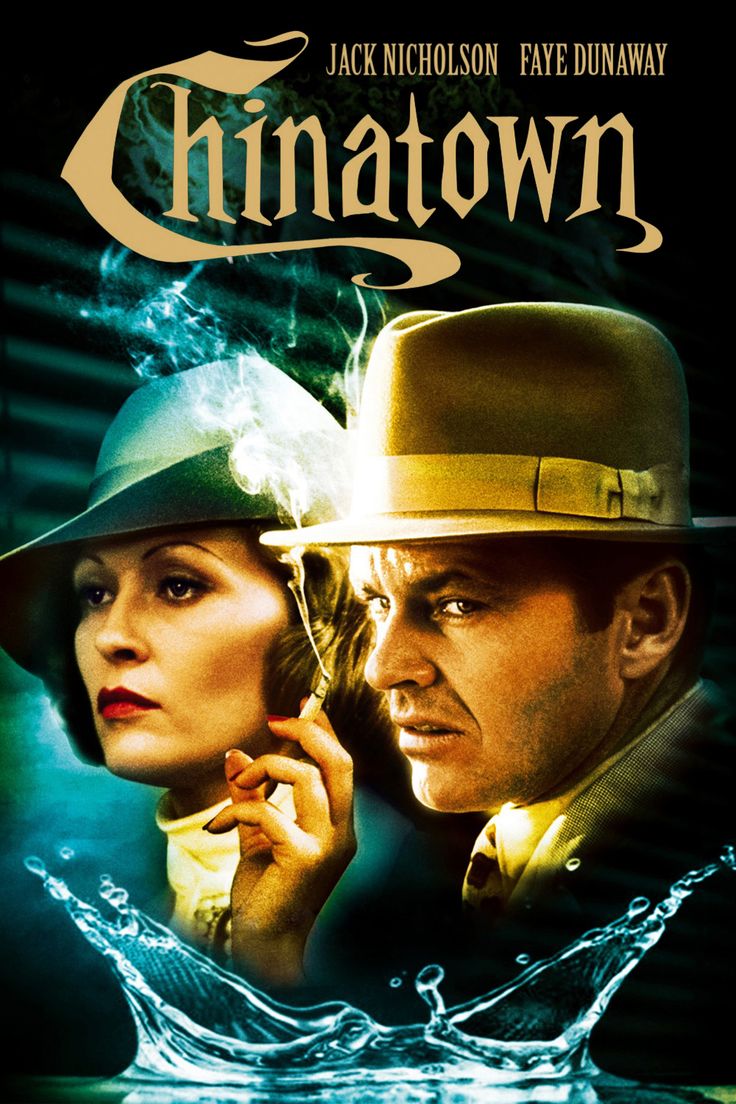
by Mark Smiley | Mar 24, 2017 | Main Articles
By: Larry Ambrose
Raises Funds And Awareness
 A few months ago on December 7, 2016, more than 100 people attended the showing of the movie Chinatown, at the Sie Film Center, in support of the lawsuit to stop the destruction of historic City Park Golf Course and the Globeville Landing Park. Both parks are part of the Platte to Park Hill Storm Drainage project (P2P) being done to enable expansion, undergrounding and partial cover of I-70 and the massive public/private development of the Platte Valley north of the River North Art District (RiNO).
A few months ago on December 7, 2016, more than 100 people attended the showing of the movie Chinatown, at the Sie Film Center, in support of the lawsuit to stop the destruction of historic City Park Golf Course and the Globeville Landing Park. Both parks are part of the Platte to Park Hill Storm Drainage project (P2P) being done to enable expansion, undergrounding and partial cover of I-70 and the massive public/private development of the Platte Valley north of the River North Art District (RiNO).
The movie, set in 1930s Los Angeles, is really about the sinister development of the then agricultural San Fernando Valley. Jake Giddis (Jack Nicholson) stumbles upon a secret plan to divert water to dry up farm land to buy it cheap and use it for massive commercial and residential development.
The panel discussion that followed featured River North (Taxi) community based developer, Mickey Zeppelin; attorney Aaron Goldhamer; and citizen activist, Christine O’Connor. Zeppelin is gratified by the grassroots momentum building to stop the current plan for I-70 and the further degradation of the Globeville, Swansea and Elyria communities. He pointed out that Giddis, a private detective, tries to fight the evil of municipal corruption by himself without the benefit of community, which results in tragic consequences. Goldhamer outlined the lawsuit against the City of Denver challenging the use of City Park for the non-park use for storm water retention for I-70 and the Platte Valley and asked for community support for the effort. O’Connor outlined the history of the project and how it coincided with the decision to underground I-70 and expand the Stock Show.
Globeville Swansea Elyria: Victim Of I-70, Stepchildren To The Stock Show and River North
In the past decade, the north Denver neighborhood known as RiNo has been transformed from one filled with aging warehouses to an artist community — and the next hot spot for commercial development. Developers like Zeppelin Development and Industry built successful office and mixed-used projects, which attracted more development. See: Denver Post, RiNo project picked by HomeAdvisor for new Denver headquarters is delayed By Tamara Chuang December 19, 2016.
http://www. denverpost. com/2016/12 /19/rino-homeadvisor-denver-headquar ters-delayed/
“Chinatown” Secret Development Plan Or Just A Coincidence: The 2026 Winter Olympics
So, where do the dots connect to a schematic where our government leaders are using a massive public/private partnership to have the the biggest developers and the power elite slop copiously at the public trough? That too, was revealed at the Chinatown event on December 7. Could the Stock Show/I-70/River North be the location of Winter Olympic facilities in Denver and an Olympic Village as part of a bid for the 2026 games? At the end of the panel discussion, NW Denver Councilman Rafael Espinoza, rose to confirm, ”All this is true. I was at a presentation recently where Kelly Leid [now head of development of the “National Western Stock Show Center“] offered up that the planned NWS facilities could be used to accommodate Winter Olympic events.”
The Omnipresence Of Brownstein Hyatt Farber Schreck

Article Author: Larry Ambrose, above, is a teacher at Metro State Denver and was the former head of INC the umbrella group for Denver neighborhood associations and others until forced out by Mayor Hancock’s administration. He had criticized some of the development projects being pushed by the Mayor’s office which were opposed by many neighborhood groups.
Political and financial influence in Denver has been centered around an elite group of institutional power-brokers and lobbyists. Chief among them is the lawfirm of Brownstein Hyatt Farber Schreck (BHFS) whose principles, Norman Brownstein and Steve Farber, not only have exerted considerable control over Denver’s municipal affairs but who also have been a major lobbying force in Washington, D.C.
BHFS’s connection to John Hickenlooper goes back to the beginning of his Mayoral administration. Cole Finegan had been with BHFS for 10 years and a partner when he was picked to serve as Denver’s City Attorney and Chief of Staff to Hickenlooper in 2003. In January 2015, Governor Hickenlooper hired Doug Friednash from BHFS as his Chief of Staff. A former state lawmaker, Friednash also served as Mayor Hancock’s City Attorney before joining the Brownstein firm.
When shortly after Michael Hancock was first elected Mayor in 2011 and his telephone number was found in copies of phone records as a client of a local prostitution ring, BHFS was retained to manage what was a very touchy situation. Fortunately for the Mayor, the original records were stolen from the home of the head pimp shortly thereafter.
Although associates and clients of Norman Brownstein were at the center of his son Bo Brownstein’s activities, the father escaped untainted. Bo was convicted of insider trading by the SEC, paid a $4. 7 million fine and served a year in prison. Farber is largely credited with bringing the Democratic National Convention to Denver in 2008. Escaping from the crashing financial markets, Steve Farber’s sons Brent and Gregg, investment bankers in New York, moved to Denver in 2008. Their brother, Brad, a lawyer at BHFS, was to join them in the development firm, Elevation Development Group.
What’s The Plan Behind The Plan?
There is a little known but very active plan to bring the 2026 Winter Olympics to Denver. How can it be that by playing a big role in the bigger plan behind the entire Stock Show/I-70/major population relocation and flood control scheme can this group of local politicians and developers stand to profit from the residents of Denver? Connecting the dots between the formation of an Olympics Exploratory Committee in 2011, the Committee’s vote to put in a bid, the US Olympic Committee refusal to submit a bid in 2012, the need for any successful future bid to have City infrastructure for venues and Olympic athlete
housing, the creation of the Northwest Denver Cornerstone Collaborative, obtaining nearly a billion tax dollars, expanding the “Stock Show” development area to 250 acres and creating I-70 at the Stock Show in such a manner as to serve as a covered transportation station (ala Union Station) to the mountains and, voilá, you have quite an Olympic venue.
Colorado Voters Rebuke 1976 Winter Olympics: Cause For Caution?
In 1976, Colorado voters rejected the Winter Olympics even after being chosen as the site by the US and International Olympic Committees. Although Hickenlooper and Hancock have not exactly hidden the effort to bid on the Winter Olympics again, it cannot be seen as an open and transparent process. One could describe the ongoing attempt to bring the games to Colorado as very low-key. But neither have our civic leaders involved revealed the connection to the North Platte Valley, keeping I-70 in place or the NWDCC and the Stock Show.
Olympics even after being chosen as the site by the US and International Olympic Committees. Although Hickenlooper and Hancock have not exactly hidden the effort to bid on the Winter Olympics again, it cannot be seen as an open and transparent process. One could describe the ongoing attempt to bring the games to Colorado as very low-key. But neither have our civic leaders involved revealed the connection to the North Platte Valley, keeping I-70 in place or the NWDCC and the Stock Show.
Denver Bids For The 2022 Winter Olympics
Created by Mayor Hancock, and Governor Hickenlooper, the Denver Olympic Bid Exploratory Committee featured such notable players as Steve Farber and Cole Finnegan as well as other downtown Denver operatives with ties to the Mayor and Governor, including: Tami Door, Kelly Brough, Elbra Wedgeworth, Richard Scharf and Anne Warhover. See: The Colorado Independent, Denver, Colorado, form official exploratory committee for 2022 Winter Olympics David O. Williams December 16, 2011.
http://www. coloradoindependent. com /108152/denver-colorado-form-official-exploratory-committee-for-2022-winter-olympics
The Recommendations in 2012 from the Operations Committee of the Exploratory Committee contains the following:
Colorado also starts in a strong position as it relates to the structural components necessary to bidding and hosting the Winter Games . . . . . . . For non-competition venues, there are seven total structures required. Of these, only the city and mountain athlete villages will require permanent construction. While these facilities will likely require some public financing to construct, they all represent opportunities for long-term legacy use. Examples of how other Olympic host cities have turned facilities into legacy opportunities include the Oval Vancouver constructed in 2010. This facility now serves as multi-use facility for the city and surrounding communities. Also, to accommodate the International Broadcast Center and Main Press Center, Vancouver 2010 expanded the existing convention center to triple its previous size . . . . . . . Additionally, Olympic villages can be used to showcase cutting edge design and construction techniques as well as to fulfill vital affordable housing needs after the Games are completed. See: The Denver Olympic Exploratory Committee Endorsement of the 2022 Winter Olympics June 27, 2012.
https://www. scribd.com/document/ 98553430/Denver-Olympic-Exploratory-Committee-Endorsement-of-2022-bid? ad_group=Online+Tracking+Link&cam paign=Skimbit%2C+Ltd.&content=10079 &irgwc=1&keyword=ft500noi&medium= affiliate&source=impactradius
In 2012, after due consideration the Exploratory Committee officially voted unanimously to put in a bid for 2022. No surprise there! Hancock and Hickenlooper sent out a joint statement:
“We want to thank the Denver Olympic Exploratory Committee for their thorough, objective work to evaluate a potential Olympic bid. It is great news to learn about the Committee’s unanimous support of a bid and we deeply appreciate the research and expertise offered in the report. We will take due consideration of the report, which will inform our decisions on next steps. ”
What Happened To The Bid For 2022?
However, not long after, in July 2012, the US Olympic Committee (USOC) dashed Denver’s hopes of bidding for the 2022 Winter Games by announcing it would sit out the competition. Denver’s Exploratory Committee was disbanded, with the intention of reviving the effort for a bid in 2019 for the 2026 games. Exploratory Committee member and 12-time Paralympic gold medalist Sarah Will of Edwards said, ”whether it’s 2026, 2030 or beyond, the Winter Olympics ultimately should be held in Colorado.” See VailDaily, An Olympic bid in 2026? David O. Williams February 14, 2014.
http://www.vaildaily.com/news/an-olympic-bid-in-2026/
Bill Marolt, champion Colorado skier, US Snowboard Assn. President and CEO and a member of the USOC Board, thinks Denver should bid. “I believe that the USOC and IOC are going to look for the best opportunities and their viable candidates, and I think Denver’s a viable candidate.”
However, Denver faced stiff competition in 2012 for the 2022 games from joint Olympic bidders in Reno-Lake Tahoe. Detrimental to a successful bid from Denver would be serious questions about infrastructure, facilities in the City and, of course, upgrading I-70.
Hancock And Hickenlooper: Enhancing Denver’s Chances For 2026
So in January 2013, the Mayor announced a major, ”envisioning” effort to “revitalize,” 3000 acres and the neighborhoods of Globeville, Swansea and Elyria and appointed Robert Moses of Denver, Kelly Leid, a protege of Oakwood Homes developer, and major supporter of Hancock, Pat Hamill, to head it up. Almost $1 billion dollars was approved for infrastructure and improvements for the “Stock Show.” See: Presentation North Denver Cornerstone Collaborative, Six Projects — One Vision by Kelly Leid August, 2015.
http://www.denverleadership.org/ wp-content/uploads/2015/08/Leid-Kelly.pdf
About the same time, in 2012, Hickenlooper ordered CDOT to study undergrounding I-70 through the Stock Show area in order to build a $2 billion partial cover over the freeway to connect the Stock Show area to the Coliseum and RiNO. As plans for both massive infrastructure projects progressed, it became clear that storm run-off flooding would put a “damper “ on all of these projects. Thus was born the Inter-Governmental Agreement between the City and CDOT to charge the citizens of Denver more than $400 million to enable the “vision.”
Do the residents of Globeville, Swansea and Elyria feel like all of this money and these projects are at all directed to “revitalize” their communities? Most do not. But what then could this $3. 5 billion plus plan be all about? Few seemed to notice when Jon Murray, city beat reporter for The Denver Post on June 22, 2016, wrote an article with the following headline. “Colorado group seeks lessons from Rio for potential Olympics bid: Delegation includes Denver Mayor Michael Hancock and Colorado Gov. John Hickenlooper.”
Murray goes on to report, “Asked about a potential Denver bid for the winter Olympics, Hancock spokeswoman Jenna Espinoza sent this statement:
“Denver has made no secret of the fact that we are interested in pursuing the Winter Olympic Games, if the opportunity presented itself. Every city we visit, we learn from the challenges and opportunities of the area. From this discussion with the Rio host committee, we expect to learn from their bid process, and overall, hear about their approaches to event hosting.” See: “Colorado group seeks lessons from Rio for potential Olympics bid: Delegation includes Denver Mayor Michael Hancock and Colorado Gov. John Hickenlooper,” Jon Murray Denver Post, June 22, 2016.
Is it just a coincidence that in 2015 Steve Farber’s sons, Elevation Development, purchased a full square block of land on the southern edge of the Stock Show’s new development boundaries? With a $10 million land deal closed, a Denver developer is firing up another major RiNo project. Elevation Development Group bought 2. 5 acres near Downing and Blake streets last month for $9.6 million. Principal Brent Farber declined to comment on specifics but said the company plans to break ground on a significant mixed-use development in 2016. “There’s a big story happening in RiNo right now, there’s a lot going on in the area,” he said. ”One thing I loved about this specific site is it’s right on the light rail stop — it ‘s just right off of the platform.” Elevation’s purchase includes the entire block bounded by 36th, Blake, Downing and Walnut streets and a separate parcel at the northeast corner of Downing and Walnut. Elevation Development, acting as Hub Development LLC, closed the deal on Sept. 17, city records show. See: BusinessDen With mixed-use plans developer buys RiNo lot for $9. 6M Burl Rolett October 1, 2015.
http://www.businessden.com/2015/ 10/01/with-mixed-use-plans-developer-buys-rino-lot-for-9-6m/
Be Here Then, Be Here Now
If only we had paid attention to Denver’s most astute observer, artist and prophet, Kenny Be, way back in 2009. He knew this was coming and even came up with a mascot!
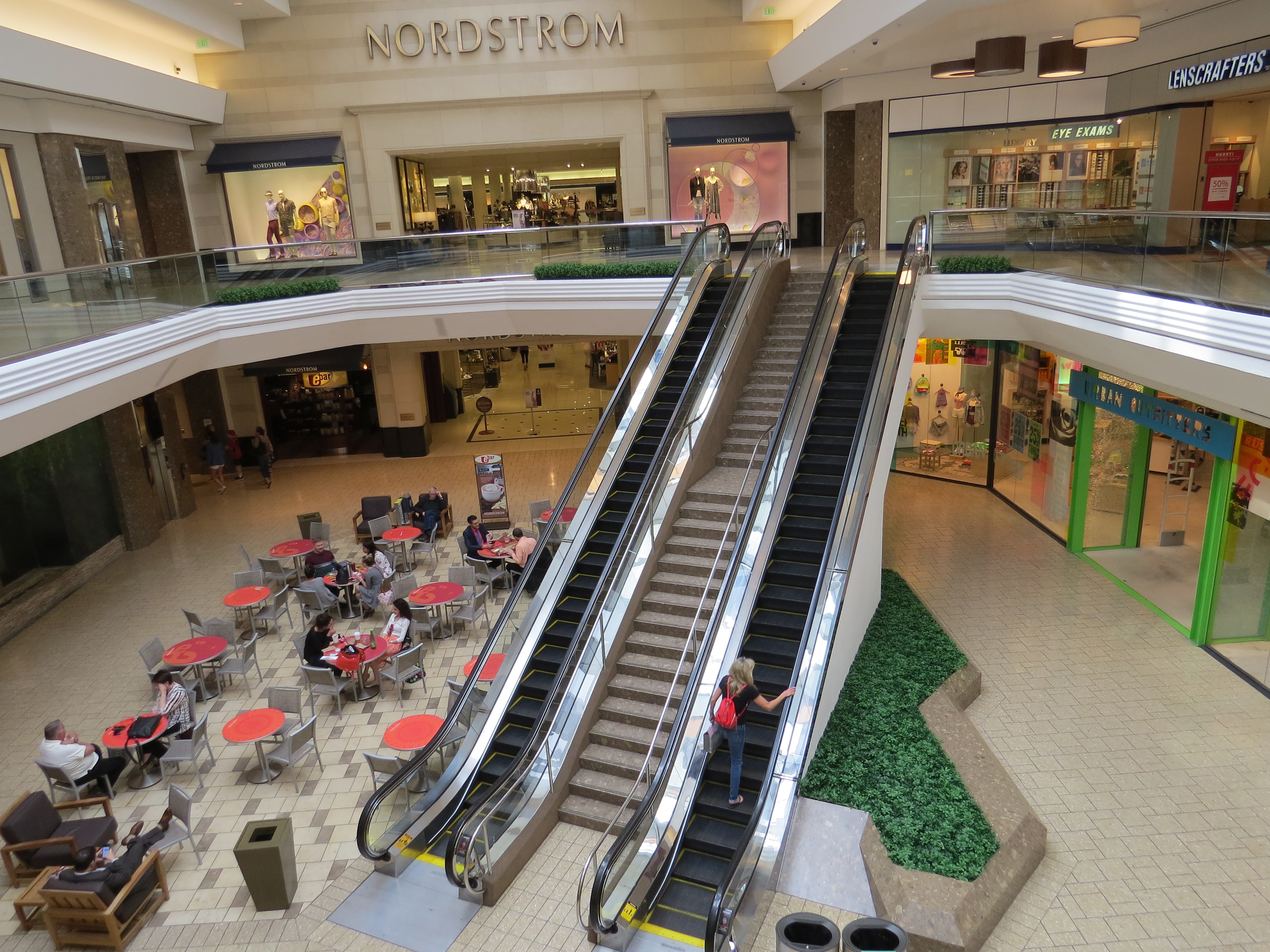
by Mark Smiley | Mar 24, 2017 | Main Articles
City’s Refusal To Plan For Traffic And Parking Causing Crisis
Bed Bath & Beyond Leaving. Elway’s Next?
by Megan Carthel
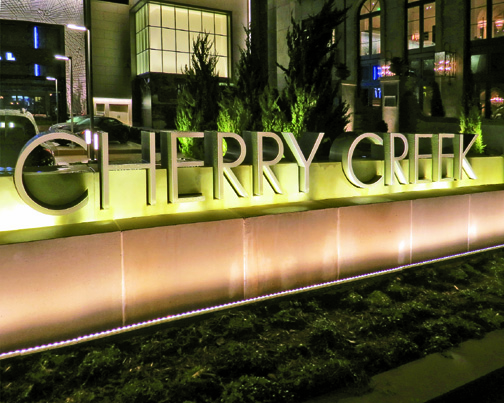 Creek Cherry was named in the 19th century for chokecherry bushes that once lined its banks. While attractive flowers bloom from the bush, if you eat the leaves or seeds you would choke and go into convulsions.
Creek Cherry was named in the 19th century for chokecherry bushes that once lined its banks. While attractive flowers bloom from the bush, if you eat the leaves or seeds you would choke and go into convulsions.
Denver’s adamant refusal to consider traffic and parking concerns in approving new developments in the area is slowly choking and destroying the retail businesses at the Cherry Creek Shopping Center and in Cherry Creek North according to experts.
When District Court Judge Shelly I. Gilman was told in a lawsuit on a zoning dispute for a new development that the City does not and will not consider traffic and parking concerns in approving new developments, she was incredulous. “That can’t be true,” she exclaimed. When the City sheepishly confirmed that it was, in fact true, Judge Gilman was still incredulous, stating that if you didn’t consider traffic and parking impacts, what did the Denver Community Planning and Planning Department and the City Council plan for?
City Reduced Parking For New Developments
Denver significantly reduced parking requirements for apartments and condominiums to a fraction of those required in other cities.
Former City Councilman Ed Thomas explained, “If they actually did consider traffic and parking impacts some projects would h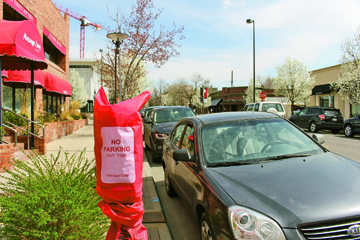 ave to be modified or even not approved and real estate developers simply don’t like that.”
ave to be modified or even not approved and real estate developers simply don’t like that.”
In January 2017, of this year, the Shopping Center was forced to introduce paid parking which The Denver Post stated in its headline as “a total disaster.” Channels 4 and 7 ran similar stories saying that shop owners reported that it was “killing business.”
Major Cherry Creek Shopping Center retailer Bed Bath & Beyond announced it was moving to Glendale this fall. There are unconfirmed rumors that Elway’s restaurant, a well-known gathering place in the center, was going to close and move to the old Cool River Café location at 8000 East Belleview in Greenwood Village.
Restaurants At The Mall
Scott Stevens, owner of Which Wich, said the move has severely hurt his business.
“The impact on my business has been horrendous. Food business in a mall is highly dependent on traffic in a mall. We are down 40 percent consistently versus a year ago, week after week after week. Which 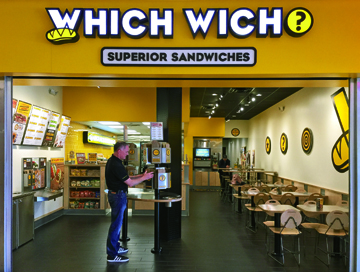 says to me the traffic in the mall is down 40 percent.”
says to me the traffic in the mall is down 40 percent.”
While Stevens’ restaurant is a fast-food joint inside the mall, he said it’s still beneficial for him to have foot traffic the mall is now lacking. Signing his 10-year lease just over a year ago, Stevens said the mall management was not upfront about making the switch to paid parking.
“Had I known they were going to start charging for parking this year, I would’ve thought twice about [having my store in the Cherry Creek Shopping Center].”
Nick Gourian of Fresh Healthy Café told Channel 7 that its business was down nearly 40 percent in March and he wrote a letter to Governor John Hickenlooper and Mayor Michael Hancock to complain about the imposition of paid parking.
Some businesses at the Shopping Center are taking proactive measures. Jennifer Olson, General Manager of Brio Tuscan Grille stated to the Chronicle, “We’ve been telling everyone eat, chat, and we will validate. Come on in and eat and drink for up to three hours and we take care of the parking fees.”
But Why?
In almost none of the articles and stories about paid parking at the Shopping Center is it truly explained why the Shopping Center would adopt a policy that has such disastrous consequences for its tenants.
The answer is simple. The City gave the Cherry Creek Shopping Center no choice in the matter. Not by any kind of direct governmental edict but by approving scores of projects in Cherry Creek North with limited or vastly inadequate parking. The Cherry Creek Chamber at an annual luncheon several years ago disputed the claim that there was inadequate parking in Cherry Creek North, declaring, inter alia, that there were 5,100 free parking places at the Cherry Creek Mall.
The Cherry Creek Shopping Center found itself flooded with cars from new hotels, apartment houses and condominium complexes with minimal parking. Moreover employers at retail and other businesses instructed their employees to also park at the center.
Nick LeMasters, Cherry Creek Shopping Center General Manager, said, “Customers have always parked at the mall and in Cherry Creek North and crossed First Avenue and have cross-shopped and that has never ever been discouraged or has never presented itself as a problem.” LeMasters added, “The challenge has been the fact that we have employees, not just from Cherry Creek North, but employees primarily in the service industries and hospitality and the retail industries who have viewed us, perhaps appropriately, as the free parking option because there’s very little complimentary parking around the neighborhood.”
Cherry Creek North

Councilman Wayne New
Wayne New, District 10 City Councilman, who won his seat in part for his willingness to take on the City and developers on planning issues, called the present situation a “perfect parking storm” not only for the Cherry Creek Shopping Center but also Cherry Creek North.
Gavin Berry, General Manager of Del Frisco’s Grille at 100 St. Paul Street, is feeling the effects. Del Frisco’s is an upscale eatery in Cherry Creek North that has seen a drop in its customer base since the transition to paid parking.
“We’ve definitely seen less traffic than we did this time last year. The sentiment is that fewer folks are coming into Cherry Creek,” Berry said.
Berry noted he’s seen about a 20 percent decrease in traffic. “If less people are coming into Cherry Creek, less people are dining in Cherry Creek and less people are shopping in Cherry Creek,” Berry said.
Aimeé Noel, Pea in a Pod store manager in Cherry Creek North, said it’s too early to tell if there has been an impact on her business but suspects there might be an effect on the area.
“I would definitely think (the 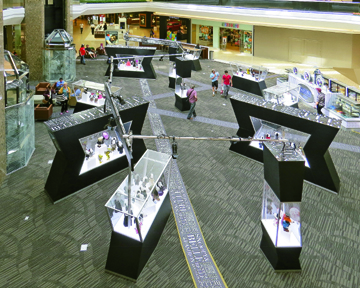 paid parking system) would have an effect on the overall area,” Noel said. She did say that she has heard complaints from customers.
paid parking system) would have an effect on the overall area,” Noel said. She did say that she has heard complaints from customers.
But Why Again?
Why would the City and County of Denver want to destroy one of its vibrant retail business areas which provides the City an estimated $10 million in sales tax revenues?
A key lobbyist in Denver revealed (not for attribution): “They just don’t care. Restaurants and retail stores do not fund political races. They do not provide future lucrative contracts or jobs for term limited politicians after they get out of office, but real estate developers can. The City also hopes that with all the new Cherry Creek area residents, some of them will not be able to have cars because there will be no place to park them, will shop in Cherry Creek and make up for the fact that no one outside of Cherry Creek will ever come back to Cherry Creek to shop again.
“Moreover if that doesn’t work and retail shopping is destroyed in the Cherry Creek area because traffic and lack of parking it is irrelevant from a financial standpoint. Denver is both a city and its own county so it gets the lion’s share of all property taxes. The money from property taxes for all the new buildings in Cherry Creek more than offsets all the retail sales taxes that will be lost. If the Shopping Center and retail shops in Cherry Creek North cared about surviving they should have bought themselves a mayor and a planning director like the real estate developers did.”
Prior to winning his council seat Wayne New was involved in various lawsuits against the City and its Planning Department for failing to require parking or traffic studies or forecasting models. Led by New, the Cherry Creek North Neighborhood Association* hired its own traffic firm, TDA Colorado, who looked at future traffic and parking needs which showed that thousands of additional parking places would be needed and Third Avenue reconfigured at a minimum to handle significantly increased traffic.
If there is any silver lining, New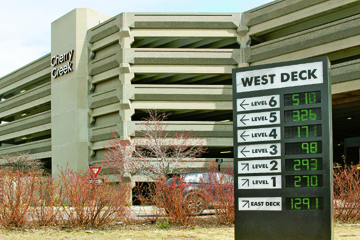 notes that some of the newer developments are putting in parking significantly well above what is being required by the City.
notes that some of the newer developments are putting in parking significantly well above what is being required by the City.
But Cherry Creek Shopping Center’s Nick LeMasters is not sanguine, “The development that’s going on around us, there’s no end in sight and there’s multiple projects coming out of the ground as we speak and several more that are imminent that will soon happen, and [paid parking] was a defensive move on [the Shopping Center’s] part.”
Most of the chokecherry bushes have disappeared from Cherry Creek and retail stores may face the same fate in the relatively near future.
* The Chronicle originally reported that the Cherry Creek North BID hired TDA Colorado to conduct a traffic study. It was in fact the Cherry Creek North Neighborhood Association who hired the firm.

by Mark Smiley | Mar 1, 2017 | Main Articles
by Glen Richardson
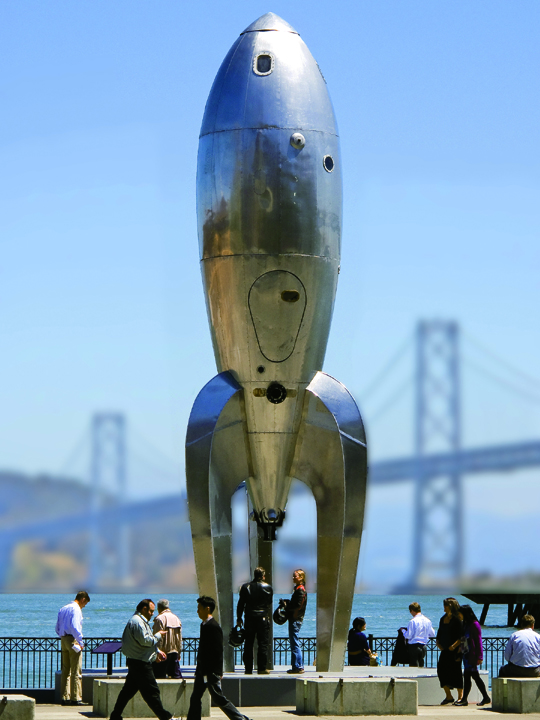 The countdown is on: The 40-foot-tall Raygun Gothic Rocketship first revealed by the Chronicle last February is landing in Lowry this May. Ground zero is the parking lot directly in front of the Lowry Beer Garden at 7577 E. Academy Blvd.
The countdown is on: The 40-foot-tall Raygun Gothic Rocketship first revealed by the Chronicle last February is landing in Lowry this May. Ground zero is the parking lot directly in front of the Lowry Beer Garden at 7577 E. Academy Blvd.
Design and construction of a Spaceport — a structural and visual base — is currently underway in front of the Beer Garden and adjacent to the Wings Over the Rockies Air & Space Museum. Landing site for the rocket was moved from its original planned location in front of the Luce Condos at the corner of East Academy Blvd. and Rampart Way following last February’s Chronicle article.
The 40-foot tall art piece is a rococo-futuristic, highly stylized vision of space travel circa 1930s-1940s science fiction. First landing and inauguration took place at Burning Man 2009, and the sculpture subsequently appeared for Yuri’s Night at NASA Ames before going on display at the Embarcadero in San Francisco for more than two years.
Rocket Plaza Planned
 The ambitious project to enliven the Hangar 2 development at Lowry is a project of Hartman Ely Investments in partnership with Larimer Associates. It remains uncertain if the project has overwhelming neighborhood support. Developers, however, are confident the compelling large-scale sculpture will engage people and enhance their experience at Lowry and Hangar 2. Without a doubt the rocket will make science fiction an everyday reality for thousands of Valley residents and visitors to Lowry. The Denver Landmark Preservation Commission has approved the project.
The ambitious project to enliven the Hangar 2 development at Lowry is a project of Hartman Ely Investments in partnership with Larimer Associates. It remains uncertain if the project has overwhelming neighborhood support. Developers, however, are confident the compelling large-scale sculpture will engage people and enhance their experience at Lowry and Hangar 2. Without a doubt the rocket will make science fiction an everyday reality for thousands of Valley residents and visitors to Lowry. The Denver Landmark Preservation Commission has approved the project.
It was created by California artists Sean Orlando, Nathaniel Taylor, and David Shulman, along with Five Ton Crane (5TC), a group of artists and inventors from the San Francisco Bay Area.
The rocket’s voyage will end at Lowry where it will become a permanent display piece. Plans call for it to be mounted atop an ice cream shop, symbolizing a launch pad. Specifically, a retail structure to sell ice cream and other retail items will be the structural and visual base for the Raygun Gothic Rocketship. It will be the centerpiece of a pedestrian plaza being built in the existing parking lot in front of the Lowry Beer Garden.
Lowry officials have not announced if the installation will be illuminated for nighttime viewing as it was during its stay at the Embarcadero.
Stellar Destination
Although yet to be announced by developers, since the pedestrian plaza, rocket sculpture and kiosk will be located directly in front of the Lowry Beer Garden, it is likely the same staff will manage the two facilities.
Like other neighborhoods in the Cherry Creek Valley, Lowry has added several public art pieces. Unlike Lowry’s existing public art — many with a flight theme — this Gothic Rocket is so evocative of an old science fiction movie, viewers will half expect a crew clad in natty jumpsuits to disembark and explore Lowry. Others may imagine it is poised to board passengers for a run to nearby stellar destinations.
If the crowds for the new Star Wars Exhibit at the Denver Art Museum are any indication, it is likely that huge crowds will take the journey to Lowry for the opening and throughout the new year. In form and function the iconic rocket’s captivating structure is apt to equal or surpass the Power of Costumes to entertain and keep visitors amused.
Sculpture Site
Hartman Ely Investments has been involved in the redevelopment of Lowry since the approximately 1,800-acre community was created from the decommissioned Lowry Air Force Base. They are credited with re-energizing many old buildings and the creation of unique new places at Lowry. The firm has been involved in the planning and implementation of several Lowry developments. Among those projects are the Steam Plant Loft, Row and Patio Homes, Grand Lowry Lofts, Officers’ Row Loft Homes, Luce and Parkside.
Nestled in the heart of Lowry, the Lowry Beer Garden exists to bring people together. Celebrating Colorado’s craft beer culture, it has more than 4,500 sq. ft. of outdoor garden area with open-air seating plus a covered pavilion. Oktoberfest-style picnic tables can accommodate up to 350 guests. Being adjacent to the Wings Over the Rockies Air & Space Museum will make it a popular sightseeing diversion.
The Beer Garden offers a selection of draft and bottled beer with a focus on Colorado handcrafted brews. It also serves up casual food featuring locally made gourmet brats and sausages, freshly baked pretzels, house-ground burgers, hand-cut fries and chef-created salads.

by Mark Smiley | Mar 1, 2017 | Main Articles
Reform Or Wasted Opportunity?
by Ruthy Wexler
 On December 15 the Denver Public Schools (DPS) announced that it would close/restart three public elementary schools — Greenlee, John Amesse and Gilpin Montessori — pursuant to its new non-subjective School Performance Compact. The outcry was enormous with parents and teachers protesting vociferously. The dispute hit the news media with the local television stations and The Denver Post doing overview stories on the subject. One Denver School Board member called the decision “gut wrenching.”
On December 15 the Denver Public Schools (DPS) announced that it would close/restart three public elementary schools — Greenlee, John Amesse and Gilpin Montessori — pursuant to its new non-subjective School Performance Compact. The outcry was enormous with parents and teachers protesting vociferously. The dispute hit the news media with the local television stations and The Denver Post doing overview stories on the subject. One Denver School Board member called the decision “gut wrenching.”
As one of the targeted schools, Greenlee Elementary, is located in the Cherry Creek Valley, the Chronicle decided to drill down and find out exactly why DPS might be closing a school against the apparent, adamant opposition of a majority of its parents — and whether such a decision, in fact, made any sense.
A (Measured) Work In Progress
On a sunny day in late January, Sheldon Reynolds, current principal of Greenlee, discussed his school with a visitor. A former teacher herself, the visitor kept expecting knocks on the door, announcing various crises. But the school hummed quietly around them as the affa ble educator described practices he and his team had put in place in order to grow a “new culture” at Greenlee.
ble educator described practices he and his team had put in place in order to grow a “new culture” at Greenlee.
Sheldon — as he’s known in the community — has been principal for just a year and a half.
Occasionally, he allowed glimmers of pride to spark his eyes, telling of students who now believe they can succeed. At no time did he denounce standardized tests, the results of which have put his position in jeopardy.
Colorado students all take the CMAS PARCC state assessments every Ap ril. These tests provide Median Growth Percentiles, a measure of how much a child has learned in a year. Results are combined into one “academic growth” score for the school.
ril. These tests provide Median Growth Percentiles, a measure of how much a child has learned in a year. Results are combined into one “academic growth” score for the school.
Before Reynolds came, Greenlee’s academic growth was measured at 27 percent. He’d been there only seven months when students took those tests again in April 2016; results had bloomed to 48.8 percent.
“I’m not opposed to standards, not at all,” said Reynolds, whose youthful looks belie years of experience. “What I take issue with is the pass or fail, all or nothing decision. DPS’s benchmark is 50 percent. We were essentially only one point away in academic growth, the indicator DPS values most!”
Making Connections
Academic growth is indeed what DPS cares about most. “We don’t judge where a student starts,” Tom Boasberg emphasized. “We care how much they improve in a certain time period. This philosophy is especially important in low income neighborhoods.”
Greenlee definitely falls into the category of low income neighborhood. Almost 95 percent of its students qualify for free or reduced lunch. Many live in public housing. Seventy percent are “direct certified”; i.e., students experiencing homelessness or foster care. Located at 1150 Lipan Street, Greenlee is a stone’s throw from the colorful Santa Fe Arts District. Isolated by poverty, residents may as well live on the other side of a wall.
“We want to remove those invisible barriers,” Reynolds said. “So we’ve made many community connections … the La Alma-Linc oln Park Neighbors Association, the Art District, a local veterinarian, an architect … We have a Running Club now, led by a local businessman. Black and brown kids see black and brown males in leadership positions; that breaks down barriers, too.
oln Park Neighbors Association, the Art District, a local veterinarian, an architect … We have a Running Club now, led by a local businessman. Black and brown kids see black and brown males in leadership positions; that breaks down barriers, too.
“And we’re not afraid to try something new! The community helped us go see The Nutcracker. Yup, all 300 of us!”
Three hundred students at the Denver Performing Arts Center? Weren’t there, um, discipline problems?
Reynolds tried to make the visitor understand. “We don’t concentrate on what our kids do wrong. If they make a mistake … we remind them of our school standards, our culture. They get a chance to correct that mistake.”
He grins. “We had a great time at The Nutcracker.”
Change
Reynolds never intended to go into education. “My dad was a  principal; I was going to do something else entirely.” Graduating from George Washington High, he chose a college in Las Vegas. But working one summer at his father’s school, Reynolds realized, “I want to work with kids.” He taught in Denver for a number of years, then took a job in North Carolina as assistant principal. After that, as principal, he built Lakewood Montessori into a high-performing, award-winning NC public school.
principal; I was going to do something else entirely.” Graduating from George Washington High, he chose a college in Las Vegas. But working one summer at his father’s school, Reynolds realized, “I want to work with kids.” He taught in Denver for a number of years, then took a job in North Carolina as assistant principal. After that, as principal, he built Lakewood Montessori into a high-performing, award-winning NC public school.
In August 2015, Reynolds came home to Denver: he’d been asked to take over Greenlee Elementary, a struggling school DPS had singled out for help back in 2010. Because he’d started Lakewood “from the ground up,” Reynolds felt he could do the same here.
“But you don’t just come in and start making changes,” he says. “You listen. You look around.
“What did I see? That the perception of the school wasn’t great. Things weren’t working. But I found some really strong pieces. The staff for one.”
Reynolds and his teachers created a five-year roadmap, a “Possibility Plan.” They adopted “HOME OF THE STARS, HEART OF THE CITY” as their slogan — and believed it. “We started building our culture through a talent dev elopment model,” Reynolds explained. “If we see students as talented and gifted, they see themselves like that. We found talents — not just academic, but artistic, athletic, leadership — and built on them.
elopment model,” Reynolds explained. “If we see students as talented and gifted, they see themselves like that. We found talents — not just academic, but artistic, athletic, leadership — and built on them.
“We did it with teachers, too. I identified the most qualified teachers, they became leaders, coaching the others. That leads to mutual respect and better teaching all around.”
“He’s given teachers the opportunity to take on leadership and it makes us more dedicated, in our classrooms and to each other,” says art teacher Jessica Plate. “I’m part of the Cultural Leadership Team. We want our students to be expressive, healthy and enlightened.”
Before, bad behavior stood out. Now, teachers rewarded good behavior with extra recess and awards. Academics took on a joyous note: students who met reading goals got to spray their principal with silly string. A blown up photo of that giggly event hangs in a hall, alongside images of Greenlee students laughing, hugging, quietly thinking.
“All that love and respect you feel?” said a teacher. “That’s Sheldon.”
Karen Dunn, Head Start teacher for 17 years, says that Reynolds is the best thing that’s ever happened to Greenlee. “His idea, that we teach to the gifted students and have faith our other students will rise to that level? It works!”
“Yes, things have improved,” Reynolds allowed. “But it takes time — years, really — to build and sustain a quality neighborhood school.”
Denver Plan 2020
The leadership of DPS also formed a plan in 2015 with a five-year goal. The Denver Plan 2020 aims to have “at least 80 percent of district students attending a high-performing school by 2020.” Since approximately half that number are still in schools DPS considers lower-performing, Boasberg feels an urgency to “increase the quality of schools.”
Denver schools are assigned a numerical rating based on test scores and other factors, within DPS’s School Performance Framework. “If a school’s SPF rating remains low for multiple years, and if academic growth is poor in the most recent year, then we mark a school — and we hope never to do this — as designated,” said Boasberg. “That’s when we put the last piece in place, a School Quality Review (SQR).”
This review is done by an independent third party.
If a school doesn’t do well on the review (SQR), it’s in danger of being closed or restarted. (“Restart” means that DPS closes the school and reopens it with a different program, chosen from submitted applications. The winning plan usually changes staff. It always — unless the current principal’s plan is chosen — replaces the principal.)
To make the process of closing/restarting schools more “consistent and transparent,” this past fall DPS put in place a new policy, the School Performance Compact (SPC), with strict cutoffs; e.g., if a school received a “1” in any SQR category, that would be a trigger for closure.
Reynolds had been at Greenlee for three months when they had their first SQR.
He’d been there just seven months when testing occurred. The almost-doubled results fell just short of DPS’s decreed mark.
“If a school has less than 50.5 percent of the growth points, they continue on to the next step of the SPC process,” Boasberg said. “Greenlee was below that mark …” Thus, another review (SQR).
How Children Learn
School Quality Reviews in Denver are conducted by a Massachusetts-based consulting firm called SchoolWorks. On November 2 and 3, 2016, their three-person team, plus two DPS staff trained by SchoolWorks, came to Greenlee.
“What we do,” says Kim Wechtenhiser, who was an advocate for charter schools before she became president of SchoolWorks, “is collect evidence in relation to the protocol’s pre-identified indicators.”
In other words, they observe how student s learn. But they look through a narrow lens. Greenlee’s excellent Spanish class or its third grade teacher who instills a love of books in his students were not mentioned in the report, which reads like a business quarterly review. To wit: “The partially effective promotion of cognitive engagement was evident in 80 percent of classrooms visited.” “The development of higher-order thinking skills was ineffective in 50 percent of classrooms visited.” “Site visit team members noted that some, but not all, students were seen answering and asking questions … however, many were observed … staring off into space …”
s learn. But they look through a narrow lens. Greenlee’s excellent Spanish class or its third grade teacher who instills a love of books in his students were not mentioned in the report, which reads like a business quarterly review. To wit: “The partially effective promotion of cognitive engagement was evident in 80 percent of classrooms visited.” “The development of higher-order thinking skills was ineffective in 50 percent of classrooms visited.” “Site visit team members noted that some, but not all, students were seen answering and asking questions … however, many were observed … staring off into space …”
Asked about SchoolWorks’ report, Reynolds said equably, “Well, it’s a snapshot. Of that classroom, that day. For example, higher order thinking is very important. But you can’t just skip to it. The teacher might have just introduced the concept. [The report] did show things we want to work on. But SchoolWorks uses that snapshot as a diagnostic evaluation …”
Onwards And Upwards
By early December, the SchoolWorks reports were in. Greenlee received “1’s” in two categories.
“We received “1’s” on the exact same questions we received “2’s on the year before,” Reynolds commented wryly. “Our classroom ratings show improvement from 2015 to 2016 but our overall score was lower. We were told that SchoolWorks essentially re-normed or raised the expectations without informing anyone.”
In mid-December, Boasberg made his recommendation: Gilpin should be closed and Amesse and Greenlee should be restarted.
On December 15, crowds of parents and teachers pleaded with the Denver School Board to keep their schools open. Greenlee supporters, citing the Possibility Plan, said they’d begun their own restart. They begged the board to put the restart in Reynolds’s hands rather than someone with no knowledge of the neighborhood.
The Board refused all requests. They felt a responsibility, they said, to abide by their new policy.
On February 2, 2017, Tom Boasberg put out the call for applications to restart Amesse and Greenlee.
Reynolds was encouraged to submit an application.
Asked if he were angry, Reynolds paused. “We had reactions. But we move forward. I’m considering this an opportunity to make the school better than ever.”
Teachers and parents were not so sanguine.
“My child isn’t learning?” expostulated Gina Jones. “That’s B.S. My daughter hated math. Now she explains the concepts to me.”
“I’m very angry,” said parent Angie Huhman. “I love the vision Mr. Reynolds created for us.”
“People will feel betrayed if you get rid of this principal,” said Amanda Johns, with three children at Greenlee. “He turned the school around.”
“What are the kids supposed to think?” said another parent. “They see their teachers working so hard, their principal devoted to them, and then some strangers come in …”
If a new program is chosen, it would not begin until September 2018. “Imagine the tension of a year knowing you’re on the chopping block,” said Jessica Plate. “Already, fifth graders are stressed, they talk about it. This school will go down, not up, if Sheldon’s not part of the restart.”
There’s a large body of research about the harm done to low income communities when schools are closed. Space permits only one quote, the mildest. “Shutting down a school is hugely disruptive,” writes scholar Vontrose Deeds of Northwestern University. “It tears apart social ties … [often] undermining the very student outcomes policymakers are trying to improve.”
“If they change this school around now,” said an angry father, “they’re teaching my son something all right. They’re teaching him that we in this neighborhood don’t count.”
Two And Two Make …
Trying to make sense of it all, this reporter’s head spins.
DPS claims “parents deserve choice.” But Greenlee parents overwhelmingly choose the current principal.
Boasberg insists, “DPS restarts only persistently low performing schools.”
But Greenlee languished in the “low performing” category for years until Reynolds, in a year and a half, pushed its trajectory sharply upward.
Why not let the seeds he’s sown so skillfully bear fruit?
“DPS is up so high, they can’t see what’s on the ground,” said one Greenlee teacher, who, like many, declined to give her name. “They’re fixated on winning some sort of prize.”
At the recent confirmation hearings for Secretary of Education, Senator Michael Bennett bragged about the reform-minded Denver school system. On the DPS website, Tom Boasberg exclaims that Denver will educate low income children, “in a way that no other city in this country has done!”
In a letter dated Feb. 10, 2017 — the deadline for receiving restart applications — CEO’s of four charter school networks assure Boasberg they can help him reach his goal, if DPS opens more charter schools. “The deadline is rapidly approaching,” they warn, alluding to Plan Denver 2020.
By February 10, Reynolds had filed an application to lead a restart under a new name, the Greenlee Community School.
Two charter schools also filed applications to restart Greenlee.
In the end — SQR’s and SPC’s and “pre-identified indicators” pounding the brain — one image stands out: a support staff member, at Greenlee for years, coming over to say, “It’s all politics, nothing to do with us. We finally got a family goin’ on here. Why would they break up a family that’s working?”
For more information and to see more photos, visit www.glendalecherrycreek .com.

by Mark Smiley | Jan 30, 2017 | Main Articles
Stunning Win Of Prestigious Prize Puts Valley’s Young Artists In National Spotlight
by Glen Richardson


The Denver Young Artists Orchestra and conductor Wes Kenney has received the 2016-17 American Prize. Selected by a panel of judges from across the U.S., the DYAO has been honored with the Ernst Bacon Memorial Award recognizing performances of music by American composers. The youth orchestra is the state’s first musical ensemble to earn the cash prize Bacon award from the national nonprofit administered by the Hal City Music Theater, Danbury, CT.
Formed in 1977 under the auspices of the Denver Symphony Orchestra (now the Colorado Symphony Orchestra), it was started as a means for the Valley’s most talented young musicians to rehearse and perform together under demanding professional standards. With headquarters on South Colorado Blvd., the organization’s five orchestras train nearly 250 students ages seven to 23 annually.
Now in his third season with the DYAO, Wes Kenney won the 2007 Grand Prize at the Varna (Bulgaria) International Conducting Competition. Last August he started his 13th season as Music Director of the Fort Collins Symphony and Director of Orchestras at CSU. He is also Music Director of Opera Fort Collins and conducts three professional operatic productions as well as many concerts in Northern Colorado. He has been guest conductor for the Denver Philharmonic, Colorado Symphony and the Colorado Music Festival. This July he will travel to Korea to conduct the Changwon Philharmonic. Previously he has been a guest conductor with the Vidin State Philharmonic and Stara Zagora Opera Company in Bulgaria as well as at the Edinburgh (Scotland) Music Festival.
Five Ensembles
The Denver Young Artists Orchestra includes five ensembles. In addition to the original orchestra or DYAO there are four training ensembles: two Conservatory Orchestras and two String Ensembles. Auditions take place every spring. Local concerts are held in metro area venues including Boettcher Concert Hall, Gates Concert Hall at DU’s Newman Center plus the Macky Auditorium in Boulder. DYAO has performed with many prominent soloists over the years, including Wendy Warner, Antonio Pompa-Baldi and Edgar Meyer. In addition, DYAO has toured internationally several times, including Europe and South America.
The youth orchestra has become well known through the annual Painted Violi

n fundraising project exhibited each year throughout the Cherry Creek Valley. Over the past 13 years it has grown from a handful of pieces to more than 22 total pieces in a given season. Other instruments have also become a part of the collection including cellos, violas, basses and a mandolin. Nearly 160 pieces have been featured in numerous galleries plus larger venues, such as Boettcher Concert Hall and the Lakewood Cultural Center.
Members of the orchestras graduate into colleges and universities across the country. Alumni can be found studying in various fields including engineering, medicine, music, and law. They attend prestigious institutions including Brown University, The Eastman School of Music, The Juilliard School, Harvard, Stanford and Yale. Alumni who continued on to professional music careers now perform in major orchestras including the Atlanta, Boston and Chicago Symphony plus the Cleveland Orchestra and Metropolitan Opera.
Support Young Superstars
Valley families hankering to hear and support these young American Prize winners have a trio of opportunities within the next 60 days. On Feb. 12 the Young Artists Orchestra performs Peter and the Wolf side by side with the Colorado Symphony at Boettcher Concert Hall, 1 p.m. The Prokofiev classic is a fantastical tale in which Peter and a myriad of unruly animals are brought to life by the instruments of the orchestra to tell a tale in which good triumphs over evil. It is a wonderful opportunity to introduce children to instrumental music through storytelling. Children will hear the music and learn about the instruments. They will also be inspired seeing these young DYAO musicians as they play with the Symphony.
Then on March 5 the Denver Young Artists Orchestra fundraising dinner is at the Wellshire Inn Event Center on South Colorado Blvd., 7 p.m. Theme for this year’s gala is Stories in Music and will allow these American Prize winning young students to tell moving and inspiring stories through music. In addition to live performances by the students there will be auctions, dinner and dessert.
Finally on March 12 there’s a DYAO Spectacular featuring all of the orchestras performing at Boettcher Concert Hall, 2:30 p.m. This program includes Rimsky Korsakov’s Scheherazade, excerpts from Beethoven Symphony No. 1, plus m

uch more. In addition to Music Director and Conductor Wes Kenney, attendees will hear the work of Conservatory Orchestras Conductor Gal Faganel and String Ensembles Conductor Carmen Wiest.
DYAO’s American Prize Honors Composer Bacon
DYAO’s American Prize is for performing music by American composers. It is named in honor of Ernst Bacon (1898-1990). He was a pioneering composer, pianist and conductor who, along with Thomson, Copland and Harris, found voice for American music. He composed more than 250 songs over his career. Winner of a Pulitzer Scholarship for his Symphony in D minor and not fewer than three Guggenheim Fellowships, he set out to create compositions that expressed the vitality and affirmative spirit of our country.


 The City and County of Denver, fresh from creating chaos and consternation among Cherry Creek retail businesses by failing to plan and provide sufficient parking and traffic flow, has now set its sights on creative destruction of small businesses along South Broadway with the innovative use of bike lanes.
The City and County of Denver, fresh from creating chaos and consternation among Cherry Creek retail businesses by failing to plan and provide sufficient parking and traffic flow, has now set its sights on creative destruction of small businesses along South Broadway with the innovative use of bike lanes. 98 parking spaces along the half-mile stretch but now there are 79, a loss of 19 spots.
98 parking spaces along the half-mile stretch but now there are 79, a loss of 19 spots. riding bicycles on the sidewalk and that makes cyclists and pedestrians feel safer.
riding bicycles on the sidewalk and that makes cyclists and pedestrians feel safer.

























